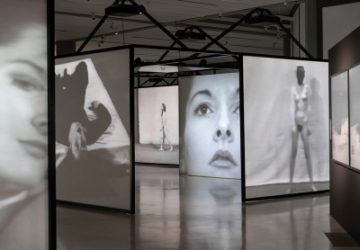Jasmina Tumbas at Art in America:
 The Belgrade installation of Sound Corridor missed an opportunity to connect Abramović’s work to that of her contemporaries. But it was nevertheless a startling introduction to an exhibition with a haunting soundscape, evocative of melancholy, death, and nostalgic enchantment. Moving from the corridor of recorded gunfire into the lobby, one could hear Abramović’s screams from the video Freeing the Voice (1975) on the second floor. For that performance at the SKC, the artist lay on her back screaming for three hours, until she lost her voice. On the first floor, a large but quiet black-box installation featured video footage from The Artist Is Present (2010), the performance staged during her retrospective at New York’s Museum of Modern Art. Opposite this installation stood Private Archaeology (1997–2015), a set of wooden cabinets holding a collection of sketches, collages, artifacts, and ephemera from Abramović’s archive, a deeply self-mythologizing installation that surprisingly did not include any reference to her SKC involvement. At the top of the stairs, large projections showed black-and-white footage of some of Abramović’s best-known works: Freeing the Voice, mentioned above; Freeing the Body (1976), in which she wrapped her head in a black scarf and danced for eight hours, until she collapsed; and several of her performances made in collaboration with German artist Ulay, including one where they slam their bodies together, and another where they sit opposite each other and scream.
The Belgrade installation of Sound Corridor missed an opportunity to connect Abramović’s work to that of her contemporaries. But it was nevertheless a startling introduction to an exhibition with a haunting soundscape, evocative of melancholy, death, and nostalgic enchantment. Moving from the corridor of recorded gunfire into the lobby, one could hear Abramović’s screams from the video Freeing the Voice (1975) on the second floor. For that performance at the SKC, the artist lay on her back screaming for three hours, until she lost her voice. On the first floor, a large but quiet black-box installation featured video footage from The Artist Is Present (2010), the performance staged during her retrospective at New York’s Museum of Modern Art. Opposite this installation stood Private Archaeology (1997–2015), a set of wooden cabinets holding a collection of sketches, collages, artifacts, and ephemera from Abramović’s archive, a deeply self-mythologizing installation that surprisingly did not include any reference to her SKC involvement. At the top of the stairs, large projections showed black-and-white footage of some of Abramović’s best-known works: Freeing the Voice, mentioned above; Freeing the Body (1976), in which she wrapped her head in a black scarf and danced for eight hours, until she collapsed; and several of her performances made in collaboration with German artist Ulay, including one where they slam their bodies together, and another where they sit opposite each other and scream.
more here.
